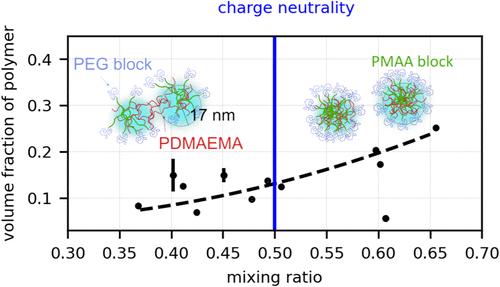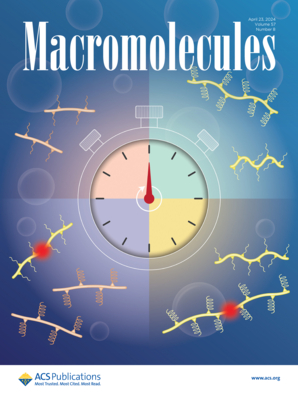Formation of Interpolyelectrolyte Complexes (IPECs) between Double-Hydrophilic Block Copolymers and Polysoaps: The Role of Hydrophobic Modification and Mixing Ratio as Structural Control Parameters
IF 5.1
1区 化学
Q1 POLYMER SCIENCE
引用次数: 0
Abstract
The formation of interpolyelectrolyte complexes (IPECs) by mixing oppositely charged polyelectrolytes has been studied extensively over the last few years. In this article, we show how the structure of IPECs formed by a double-hydrophilic anionic block copolymer and hydrophobically modified poly (2-(dimethylamino)ethyl methacrylate) (PDMAEMA) is affected by the mixing ratio and the type and quantity of hydrophobic modifications of the PDMAEMA. Static and dynamic light scattering as well as small-angle neutron scattering (SANS) reveal the role of hydrophobic modifications on large-scale aggregation behavior. Modeling SANS data with a cluster of hydrated spheres formed by the polymeric species enabled us to see that the aggregates become less hydrated upon switching from polycation to polyanion excess, and larger and more well-defined aggregates are formed with hydrophobically modified PDMAEMA.

求助全文
约1分钟内获得全文
求助全文
来源期刊

Macromolecules
工程技术-高分子科学
CiteScore
9.30
自引率
16.40%
发文量
942
审稿时长
2 months
期刊介绍:
Macromolecules publishes original, fundamental, and impactful research on all aspects of polymer science. Topics of interest include synthesis (e.g., controlled polymerizations, polymerization catalysis, post polymerization modification, new monomer structures and polymer architectures, and polymerization mechanisms/kinetics analysis); phase behavior, thermodynamics, dynamic, and ordering/disordering phenomena (e.g., self-assembly, gelation, crystallization, solution/melt/solid-state characteristics); structure and properties (e.g., mechanical and rheological properties, surface/interfacial characteristics, electronic and transport properties); new state of the art characterization (e.g., spectroscopy, scattering, microscopy, rheology), simulation (e.g., Monte Carlo, molecular dynamics, multi-scale/coarse-grained modeling), and theoretical methods. Renewable/sustainable polymers, polymer networks, responsive polymers, electro-, magneto- and opto-active macromolecules, inorganic polymers, charge-transporting polymers (ion-containing, semiconducting, and conducting), nanostructured polymers, and polymer composites are also of interest. Typical papers published in Macromolecules showcase important and innovative concepts, experimental methods/observations, and theoretical/computational approaches that demonstrate a fundamental advance in the understanding of polymers.
 求助内容:
求助内容: 应助结果提醒方式:
应助结果提醒方式:


